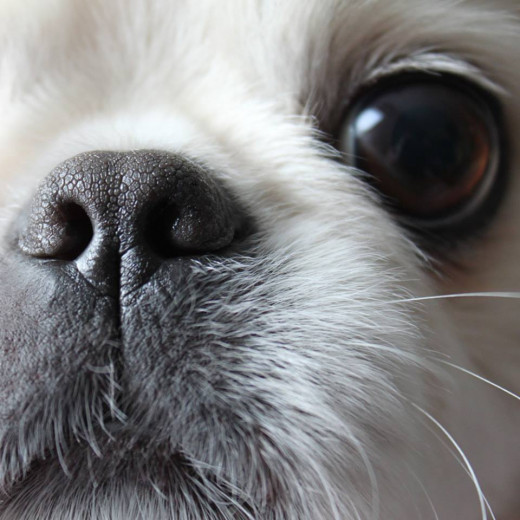- HubPages»
- Pets and Animals»
- Dogs & Dog Breeds»
- Dog Breeds
Breed spotlight; The Pekingese
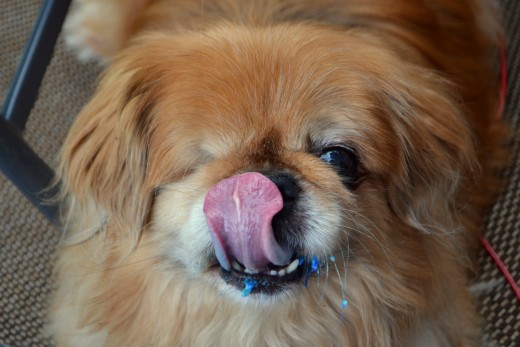
The basics
The Pekingese has a rich history, and were often owned by Chinese royalty. They were also referred to as the "Fu" dog, because of their resemblance to Chinese guardian lions. The Pekingese, affectionately known as "Pekes" by their owners, have 2 coat types. The most common is long-haired, double coated '"flufball-like" fur. It also comes in a thinner, medium-length coat. Pekes come in many different colors. They come in sable, red, black and tan, blue, all black, parti colored, and white. All accepted colorings by the AKC. They can also be "albino", being pure white with pink eyes, whitish/flesh-colored snout, and skin around the eyes. However, the albino Pekingese is often wrought with major health issues like deafness, blindness, and other congenital problems, and should be bred only by very experienced Pekingese breeders, who have a great knowledge of genetics. Pekes have a brachycephalic head (flat-faced). They have large protruding eyes, and their tail curves up over their back.
The Pekingese breed is a wonderful, loving breed, however, they are definitely not for every household. They are an intermediate-level breed, and someone in the household should have some experience with dog ownership. The Pekingese is a breed that can have a lot of health issues. Because of their brachycephalic heads, they often have respiratory and breathing problems. Their large protruding eyes are prone to ulcers, and can be injured quite easily. They are prone to eye prolapse, where the eyeball actually pops out of the socket. It can popped back in, but should only be done by a veterinarian. It's also not at all uncommon to see a Peke with only one eye. I actually have a Peke that only has one eye, his name is Peek-a-Choo. I adopted him about 5 years ago, and he was already missing his eye, so I don't have the backstory on what happened. It does not slow him up a bit, however. Pekes can also have skin allergies, which is often genetic. So typically, Pekes will cost you more in vet bills than most other breeds. While this isn't always the case, it definitely not uncommon. Having an "emergency fund", should you chose the Pekingese breed, is a very good idea.
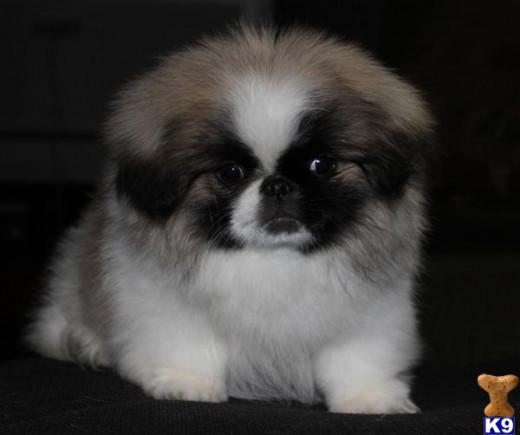
Peke temperament and personality
Though Pekes are a very loving breed, they are generally not the most child-loving breed. They will put up with a bit of manhandling by children, definitely not nearly as volatile as the Pit Bull, the Chow-Chow, Neapolitan Mastiffs, Cane Corso's, and the likes. However, they are not as laid back with children as other breeds like the Newfoundland, Golden Retriever, Saint Bernard, etc. They should be monitored closely when around small children, and children should not be allowed to pull at, tug on, or roughhouse with a Peke. They generally prefer adults and probably aren't the best choice for households with very small children. Their pushed-in faces make it difficult for them to get a large bite or strong hold when they do nip. But as a whole it's a good idea to be cautious with pairing the breed in a household with several small children. Their inability to tolerate lots of tugging and handling by small children, coupled with the fact that though the breed is not built as slight as certain other toy breeds, like Italian Greyhounds, or Chihuahua's, their bones aren't built to withstand a lot of pressure or manhandling. So again, homes with small children, may not be the best fit.
Pekes can be aloof with strangers, but are very loyal and devoted to their owners. They are brave and daring, and are full of personality. They are also stubborn though, and can difficult to train and housebreak. Training them takes time and a LOT of patience. Time and effort must be taken to train this dog, as well as socialize it, from early on, in order to prevent you from having a tyrant on your hands. Housebreaking early is important, and unlike some breeds, crate-training can be an effective, proper method for this breed. Many owners will tell you that their Pekes have gone to some extremes to potty inside, including hiding behind or under a chair, under a bed, or go to a room that isn't used often, so they can do their business inside. Once they are housebroken though, they are a habitual breed, and will stick to their potty routine.The Pekingese has a lot of bravado, and act like a big dog, though they live in a little body. They are affectionate and loveable, and oh-so huggable. They are great lap dogs, and enjoy sitting on the couch while you watch tv, and better yet, sitting right atop your lap. They are real characters, and enjoyable to watch as they play, and ham it up. They do well amongst other Pekingese in a household, and can be great with other breeds that live in the household, especially larger breeds, unlike many toy breed dogs who don't do as well, living with large breed dogs. Many Pekingese owners will tell you that they cannot have just one, and are the proud owners of two, three, even more Pekes!
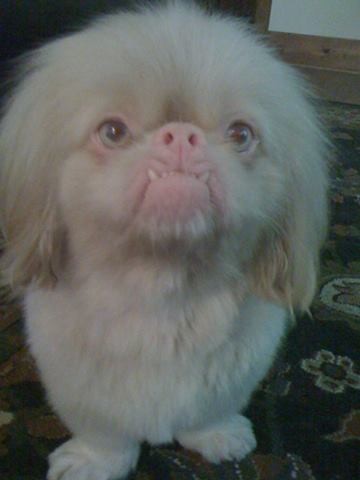
Peke care
The breed also has extensive grooming needs. Their super-thick, dense double coat needs to be brushed often. Usually every other day if their fur is kept at full length. They need a professional grooming every 6-8 weeks or so, which can get expensive. Some people have their Pekes coat cut into a "teddy cut", where the fur is cut down to a fluffy teddy bear-like length. Trimming in-between the pads on their feet is important, because as it grows out long, it's very easy for it to get debris stuck in there, and can also mat. If a Pekingese is not brushed and groomed regularly, they are extremely prone to matting of the fur, which is painful as the mats weigh more and more, and pull at their skin. And when the mats are cut off, they can be very close to the skin, and it's easy to cut their skin. A Pekes grooming needs are definitely not for a household where taking the time to do a thorough brushing frequently, is a real time concern. Also, financially funding professional grooming every 6-8 weeks, is something to be considered as well. So grooming needs for Pekingese, is generally speaking, pretty high-maintenance. Also, contrary to popular belief, there is no such thing as a "hypoallergenic" dog, some breeds produce less dander and allergens than others, and this breed is definitely not one of those breeds. Pekingese are not "outdoor dogs". With their heavy coat, they can withstand colder temperatures better, though leaving them outside in the snow for long periods of time, isn't a good idea. Hot temperatures are a real detriment to the breed, who are already prone to breathing problems due to the shape of their face. Coupled with their long, double coat, leaving them out in the heat for more than 15 minutes or so at a time, is not advised.
When it comes to barking, Pekes will bark. However, unlike certain breeds, such as the Miniature Pinscher, they will generally only bark if they have something to bark at. Having a Pekingese as well as a "barker breed" Min Pins (along with my other breeds), I can personally attest that my Peke, really only barks when someone comes to the door, and that's mostly because my Min Pins bark when someone knocks at the door, or rings the doorbell (as well as every time the wind blows past their butt). Otherwise, not a peep. So generally, they are good apartment dogs when it comes to barking.
Their exercise needs are pretty minimal. Like any dog, they will need some exercise. All dogs need some amount of exercise. But some need a lot more than others. The Peke being a small breed dog, that have short, stout little legs, with a slower metabolism than that of a Greyhound, Chihuahua or Border Collie, minimal exercise is appropriate. Taking your Peke on a daily walk is a good idea. However, if you have a decent sized fenced-in yard, they can get all their daily exercise with a daily romping in the yard. Even in an apartment, they can get their needed exercise, if they get the needed playtime in, be it with other dogs in the house, or with humans in the house playing fetch with their Pekes favorite toy, making him do some running to go fetch it. When taking your Peke for a walk, it's important to remember that their brachycephalic faces make it more difficult for them to breathe sometimes, and their very long, thick coats can really make it even hotter for them, on warm days. So when taking them for a walk, a very long walk, is not a great idea, especially on hot days. Pekes do like to go on walks, and it's good exercise, so you don't have to skip them, just keep an eye on their energy level when on the walk and pay attention to signs of overheating like heavy panting.
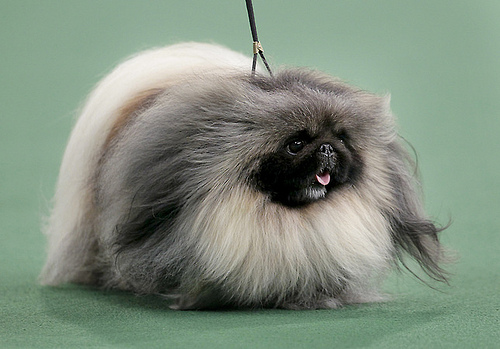
Pet Pekes vs show Pekes
The Pekingese is, (excuse my French), one HELL of a show dog! They have not only won best in group at the Westminster Kennel Club Dog Show a lot, they have won best in show on many occasions. Their beautiful coat, and endlessly adorable face, along with their charming, rolling gait, make them a crowd favorite, and a joy to handle and show. Competition in the breed is tough, with quality breeders spending an upwards of $3,000 or more for a quality Peke. "Regular" non-show dogs, kept as pets are not as expensive. But because of small litter size, and difficulty in whelping, sometimes resulting stillborn pups, or pups that die within the first 24 hours of birth, it can cost more than many other breeds, to buy a Pekingese puppy. Generally, the average cost of a Peke pup from a breeder is $400-$950 depending upon the area you live in, amount of local breeders, etc. Of course, this isn't always the case and can cost less or more, again, depending upon the breeder, the "quality" of the pup (being a pup with show potential vs a pet-only pup), and the area you are in. There are breed-specific rescues devoted to the Pekingese, and you can find Pekes in need of a home in local shelters. Sometimes though, they have been surrendered due to the fact that the Peke may need expensive vet care that the owner cannot afford, the Peke may be ill-groomed and covered in mats because the owner doesn't have the time or money to devote to grooming, or being done by a groomer, and a Peke may be surrendered because it is older and just generally not the young, playful puppy it once was. (which in my opinion, is rotten). So be sure to check your local shelter or Pekingese rescue, for loving Pekes in need of a home. It's also my opinion, as well as the opinion of many-a Peke lovers, that they grow old gracefully, and can still be playful, even in their old age. And please be aware that just because an adoptable Pekingese only has one eye, it doesn't mean he/she is slowed down by it one bit, and don't let it deter you from adopting a wonderful one-eyed Peke!
That being said, depending upon your situation, buying from a breeder might be the best choice. And when buying from a breeder is your decision, it's REALLY important to buy from a reputable, quality breeder, that really cares about their dogs, and is knowledgeable about the breed. Because of the health problems a Peke can be prone to, you need to ask about the bitches and sires (mother and fathers), health history, their genetic line, and get your puppy checked out by your vet within a few days of bringing your him/her home. Buying from a good breeder, as opposed to buying from a chain pet store or a fly-by-night, "oops litter" breeder, could save a lot of money in vet costs, but most importantly heartache down the road, as a pup from a solid genetic line, can mean the difference between your Peke living to be 6, and your Peke living to be 12. The average lifespan for a Peke is 12-13 years old, though they can live to be 16, but can also have a shorter than average lifespan, if not kept in good health, or poorly bred.
So, if the Pekingese is a good fit for you and your family, I can personally attest that they are just a wonderful, excellent dog, that is loving and sweet. When choosing a breed, it's important not to just go by their "cuteness level", you should always do your research, and choose a dog that fits your lifestyle, and family type. The Pekingese is in my opinion, (and the opinion of so many), to be one of the hands down, cutest of all breeds, especially as a puppy! It can be tempting to jump right into getting a Peke simply by looking at their adorable faces. But making sure they are the right fit is so important, as the number of Pekingese that are being surrendered to shelters and rescues, is on the rise, and has been for the past decade or so. They require good training, time, grooming, and patience.
Bringing a Pekingese into your home, can be an extremely rewarding and fulfilling thing! Great lap dogs, with the most adorable of faces, this is a wonderful breed, and one of my personal favorites (and I have owned many different breeds, and love all breeds, so that's saying a lot)!
